Wise food storage is important both for safety and longevity of your foods. Did you know that when you vacuum seal food, it stays fresh 5 times longer than other conventional storage methods? Because vacuum sealing removes the air from the container (reducing oxidation), foods such as beef, poultry, fish and even vegetables can have an extended freezer life– up to 3 years!
How to vacuum seal food for wise food storage:
I’ve laid out a quick explanation of how to go about using your vacuum sealer to safely and quickly store your food.
Let’s get started!
Supplies you need to vacuum seal your food:
- vacuum sealer (I use the Foodsaver)
- vacuum sealing bags
- vacuum sealing roll – (to make my own bags)
- scissors
- food for storage
Step 1:
I’m going to use my vacuum sealer to store my chocolate chia survival bars as well as some beef jerky I made recently.
The chocolate chia survivor bars are small, so I’m going to use one of the small vacuum sealing bags.

Step 2:
Make sure you have your vacuum sealer plugged in. Grab your bag of food and place the open end so the edge of the bag is lies in between the two foam sealing pads. This is where the suction happens so don’t push the edge of the bag all the way into the machine.



Step 3:
Lock it down! Press the tab on the right down until it clicks. For the FoodSaver I’m using, you’ll have to press fairly hard.
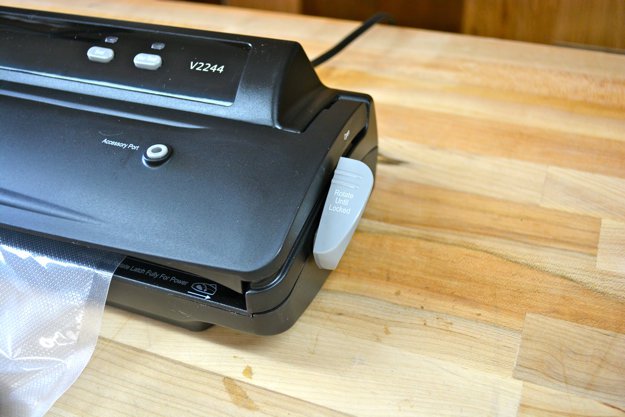



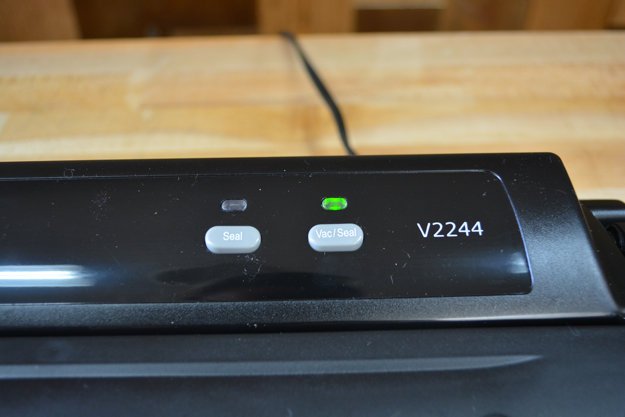



Step 4:
Pull the tab up to unlock your bag and check the seal to make sure there aren’t any wrinkles or holes.






Now I’m going to use the roll to make a custom sized bag for the beef jerky.
Step 1:
Lay the roll out along side the beef jerky to measure how long your bag will be. You will want to leave 3 inches from the end of the jerky to the edge of the bag.










Step 2:
You now have two open ends, so before you put anything inside, you’ll want to seal one end.







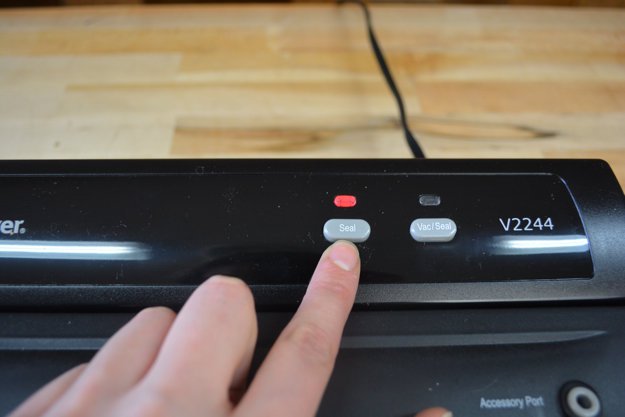



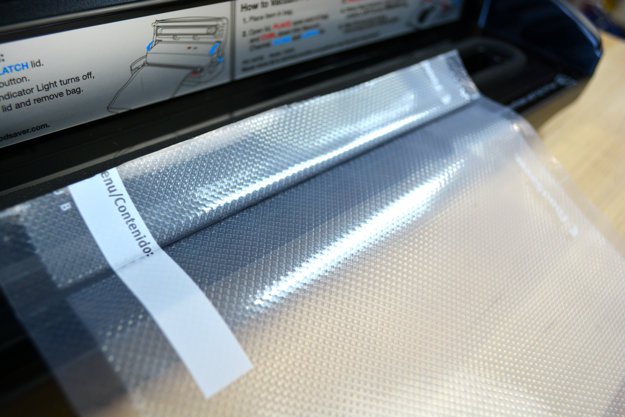

Step 3:
Place the beef jerky inside the bag you just made. Get ready to vacuum seal it!




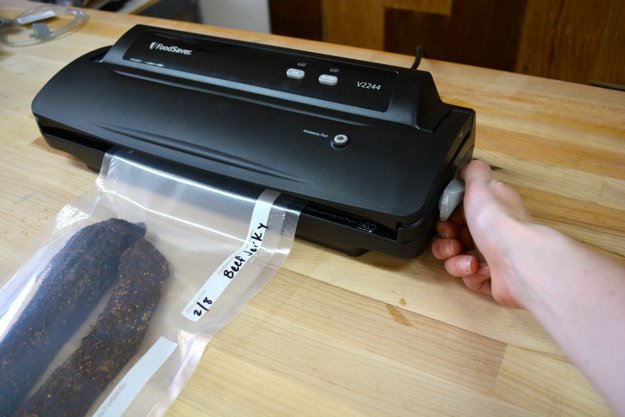









Some helpful hints:
- Avoid overfilling the bags in order to ensure a suction and seal.
- If you are sealing items with sharp edges, wrap the food/item in a cloth first (paper towels work too), then seal.
- If you are wanting to store fruits and vegetables, you’ll need to pre-freeze the fruits and blanch the vegetables before you vacuum seal.
Wise food storage can be quick and easy with these tips we just provided.
Want to make homemade survival bars like ours? Try these:
Chocolate Chia Homemade Survival Bars | Recipe
Homemade Survival Bars | Recipe | Instructions

I love my FoodSaver! I have found freezing prior to vacuum sealing works best for soups and cooked meats I want to package with gravy or juices. These items can be “cooked” later by placing them (unopened) in a pan of boiling water. No fuss, no muss. I also vac-pack my seeds (sunflower, hemp, pumpkin, etc.) to keep them fresh much longer. Since my freezer is full, I just store them in my basement. I purchased the canning jar sealing attachments so I could put my dried herbs in vac-packed jars. Again, longer freshness is the goal.
i have vacuum sealed handguns in them also works very well
How about sharing your recipes for the chia bars and your beef jerky?
What a waste of my time !!! Here’s a tip … Read The Directions That C ame With The Machine.
When vacuum sealing, be careful about sealing anything with moisture. This creates an anaerobic environment that can cause anaerobic bacteria to multiply and cause problems.
I like a vacucanner. This is a canner attached to a vacuum pump. You load dry foods into canning jars, with loose lids and run the pump to pump all of the air out of the canner. You then turn a release that instantly puts air back into the canner, sealing the canning jars. This protects the food even more than the vacuum bags. They still should be stored in a cool dark location for longest storage. The canning jars can be reused if they have only been used in the vacucanner and not in a heated pressure canner.
Perhaps this is a dumb question, but if you seal frozen stuff, or veges, or meat, do you put them in the freezer after? I am new to this, so be easy on me!
I have a used one that was passed on to us by family that I haven’t tried yet- I feel more motivated now! I’d love to hear more on using vacuum sealing for veggies and fruit. For example, I dehydrate apples and would like to store them for later. Also, what are your thoughts about using a de-oxyigenator packet with vacuum dealing dry foods?
Vacuum Sealing is not just for food. It compacts and protects other items. I vacuum sealed (VS) a space blanket and bag. They’re smaller and protected. Part of my every day carry is a bandanna and 1 or 2 white handkerchiefs. I VS’d a couple of extra sets for our GOOD Kits. The handkerchief is a good dressing and the bandanna is a good bandage, in addition to the other things a bandana/handkerchief are good for. I VS cells and batteries. They’re protected, in the needed quantity and don’t short against each other and discharge. Use a magic marker to write the date on things that expire.
Awesome tip for storing items items other than food with your vacuum sealer. Thanks!
I strongly suggest sealing each bag twice. By the design of the FoodSaver bag after first seal, it is very easy to do a second seal near the top. This gives you extra protection incase one of the seals fails.
Also I find that this gives me a much larger area to mark what is in the bag including the day, month and year. This allows me to stack these flat vacuumed sealed packages on end like filing cards and quickly read the item and date without having to pull the full package out to determine what is in it.
Almost everything in my bug out bag has been vacuumed sealed. I get more storage, protection for that item and an extra bag to use for whatever I may need it for once I open the seal and remove the item within.
Cool tips for vacuum sealing. Thanks!
A picture paints a thousand words. Love these DIY articles !
Thanks!
How to vacuum?? Buy a vacuum sealer. Wow. You forgot to mention that step 1 shoud be write the label.
Great article. I was curious but hesitant. Now I see and understand!! Next on my list!!
So happy to hear it was helpful. Good luck with your first vacuum sealing project!
I have used my food saver a lot. What I have found is that the seal is not always perfect, therefore I double seal both ends. Even this has failed once in a while.
Great tip for vacuum sealing food. Thanks!